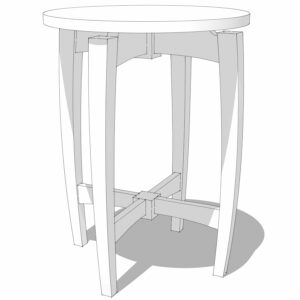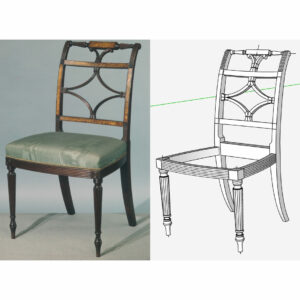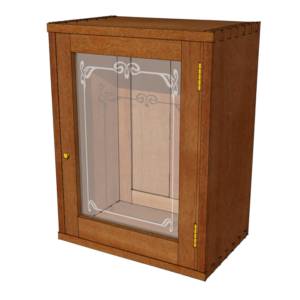Associate Editor, David Heim, asked me for some hints for drawing a turning gouge in SketchUp. I worked up a little video to show my approach. Although I’ve never drawn a gouge before, the process is similar to that used in many other models. When I am drawing detailed features on any model I tend to think about how I would make it if I were working with real wood or metal in this case. For this model I started with a long cylinder-a piece of rod stock. I cut the channel or groove in the side by drawing a shape that represents the volume of space a tool would occupy as it makes the cut. When I got to the bevel, I thought about how the tool would be rolled on the tool rest at the grinder. This showed me that a cone centered on the axis of the cylinder would be needed.
As you draw your models, try thinking it through as though you’re working with real materials. You might find that helpful.























Comments
Dave,
Thinking in terms of how a thing is made in the real world can be very useful when trying to think through how to model it in Sketchup (particularly for the inexperienced), however, this method doesn't leverage several of the advantages that exist only in the Sketchup world. For example there is no real world equivalent for how the arrow keys can lock the direction of travel parallel to one of the axises. Additonally, Sketchup's uses of inferences is very powerful and has no real world equivalent. Using inferences can dramatically reduce the number of construction lines needed and thus make model building more efficient. A good primer on inferencing is http://www.youtube.com/watch?v=rDvwHon6-zY
Yes, I know the inferencing tools extremely well as well as the arrow keys and yes, they have no real world equivalents.
I would like to know what tool you are using in sketchup,to draw such thin and crisp lines? my(lines) are all to thick and not crisp at all.
Thanks for anny help.
Jack.
Jack, my lines are thin because I've unchecked Profiles in the Edge styles settings dialog. Go to Window>Styles and click on the edit tab. See the image here: http://img.photobucket.com/albums/v506/weekender410/Styles.jpg
You can make that change part of your starting template by making editing the setting along with other settings such as the back face color. Mine is set to green as shown on the cylinder in the screen grab linked to, above. You can also change background color if you wish. Mine is set to white. Then go to File>Save as Template, give the file a name and check Use as default template. Then save it. Do this with a blank drawing so you don't have the template opening with the something you've already drawn.
There are some additional settings you can adjust for your starting template. These include increasing Precision and removing Length Snapping if you wish. Change these settings under Window>Model Info>Units.
Dave
Thank you. An excellent training video. You answered a multitude of questions (probably without realizing you were doing so). I guess only practice will bring someone to the point where they would think of using a cone to define the bevel of he gouge. Great example to make me think of ways to do other similar tasks. Again, thanks.
DaveS, that's nice to read. I'm glad that there was something to spur you to think in sort of out of the box ways about approaching things. That's always part of my goal with these sort of odd videos.
Dave,
I keep coming back to this article. I think you did a great job on it. One question that I think would be interesting to cover in a post might be how to handle intersection (or maybe another tool is better) to assist with planning turnings. I was trying to model a simple segmented turning in light and dark wood. I build my cube (think rubix type construction, 9 blocks alternating color) and intersect a dome with it... Is there a way to have the faces that remain with the "blocks" color the same as the original block? I am not sure that I am covering this clearly, let me know if this does not make sense....
Drake
Hello Drake, I think I understand what you're asking about. I can make up something about doing the intersection. As far as getting the materials to be applied to the new faces, you could do this: Assume your "Rubik's cube" is made of two different kinds of wood (walnut and maple) and for ease of description, you want to turn this cube into a sphere. Make all of the geometry for the walnut blocks one component and all of the rest a second component. In this case you won't make each small block of wood a component.
Draw the sphere and make a copy of it. Paint one sphere with the walnut material and the other in maple. Cut (Ctrl+X) each sphere in turn and put it inside the corresponding component. Run the intersect and delete the waste. When you've done this for each wood, you should have everything painted as you wish.
I'll try to demonstrate that but it'll take me a few days to get to it.
Dave
I forgot to say thank you.
Thank you.
Dave
Dave,
Any chance of getting this video back?
Thanks,
Matt Lewis
Hi Matt,
My apologies. That video got consigned to the ether when Blip.tv decided they wouldn't host my videos anymore. I'll see if I can make up a new version in the next few days and post that one.
Dave
Thanks Dave! I remember some of the steps, but could use a refresher. I appreciate your quick response and taking the time to replace it.
Best regards,
Matt
Log in or create an account to post a comment.
Sign up Log in